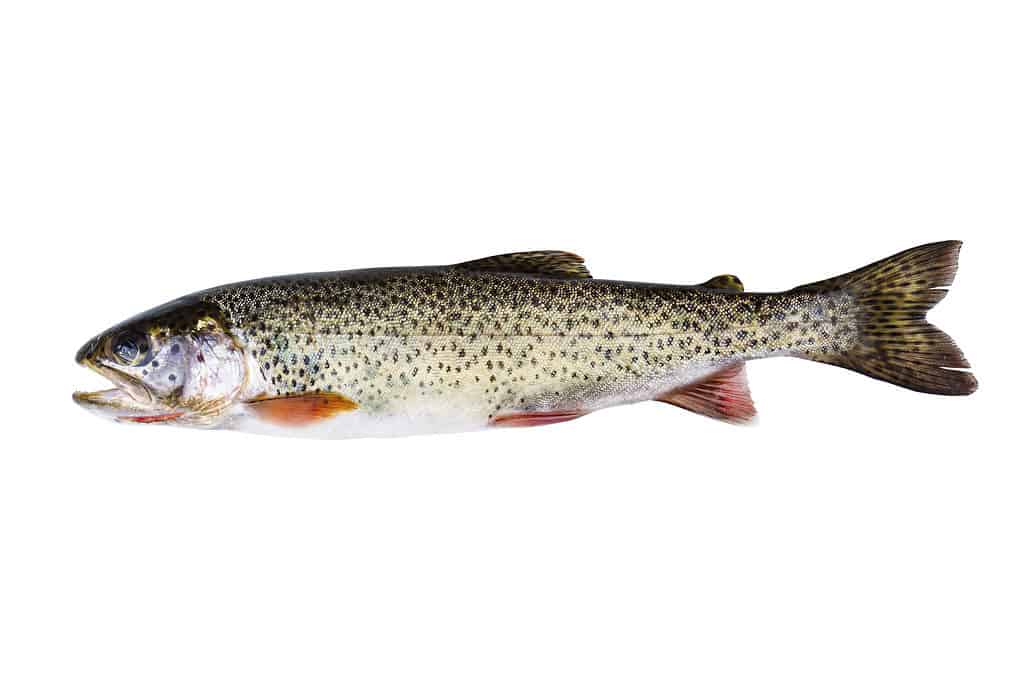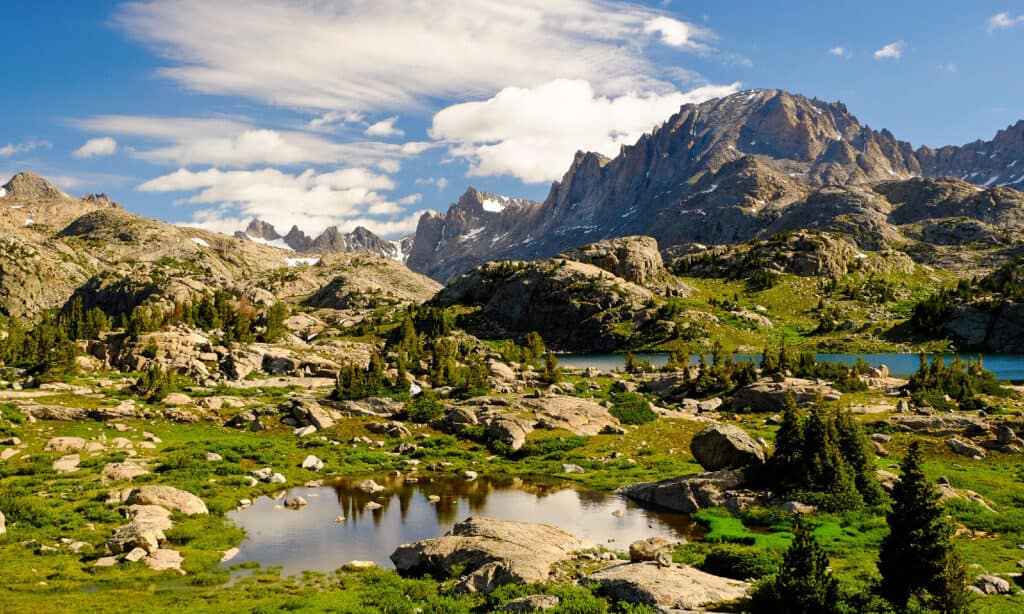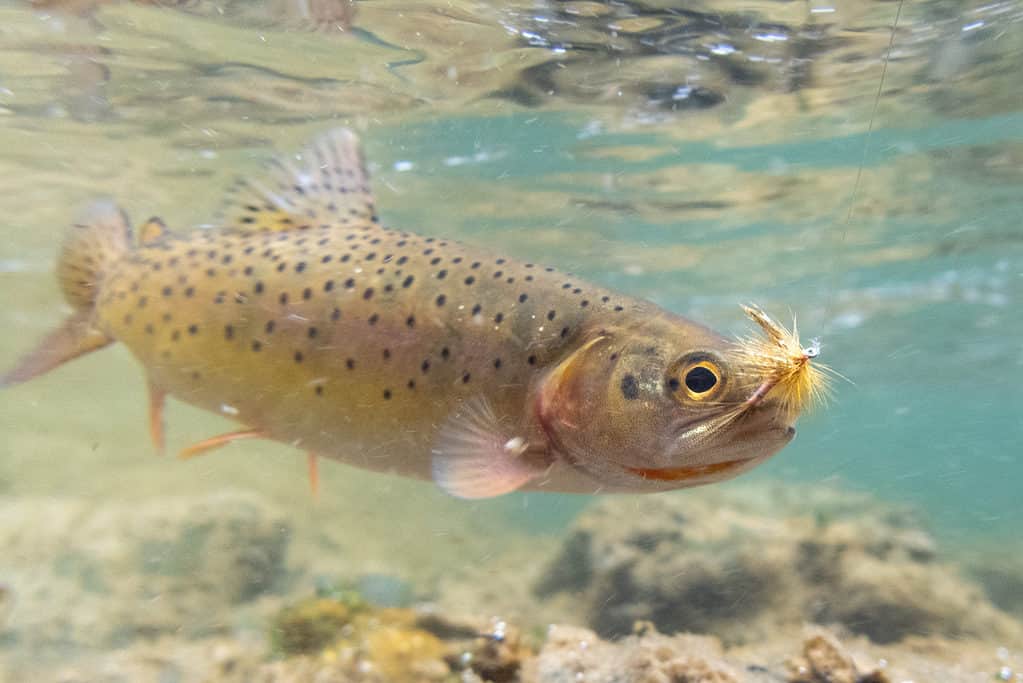Everybody knows about state animals, but what about state fish, specifically? There are quite a few states that have their own designated state fish that represent the diversity and beauty of their respective environments. If you’re from Wyoming, you’ll be pleased to hear that you have a state fish as well! In this guide, we’ll reveal what the state fish of Wyoming is and everything you need to know about it.

The Official State Fish of Wyoming
The state fish of Wyoming is the cutthroat trout or Oncorhynchus clarkii. It is a unique species of fish that is endemic to western North America. Anglers, environmentalists, and nature lovers all take an interest in the cutthroat trout. This is due to its distinctive patterns and vivid colors.
The cutthroat trout has a really stunning look to it. The striking red, orange, or pink “cut marks” or slashes on the bottom side of its jaw, which mimic the scars left by a knife, are where it gets its name. Its distinctive markings and general coloring make it easy to recognize. Cutthroat trout have a variety of colors, ranging from olive-green to blue-gray on their backs, and bright colors of yellow, pink, and silver on their flanks. They also have tiny black patches all over their body, which adds to the elegance of their look.
Life Cycle
The cutthroat trout’s life cycle is comparable to that of other salmonid species. During the spring, they often lay their eggs in streams with gravelly bottoms. By shifting the pebbles with their tails, female cutthroat trout create a redd, which is a nest-like depression in the streambed. They subsequently lay their eggs, which the male cutthroat trout fertilizes right away. The adults watch the redd after the eggs are covered with gravel. Doing so keeps it safe from potential predators until the eggs hatch.
Cutthroat trout hatch from their eggs as alevins, which are tiny, yolk-sac-containing larvae. Alevins spend a little time in the gravel and eat the yolk sac’s nutrients to stay alive. The yolk sac is absorbed and the baby trout develop into fry as they grow. As they grow, fry progressively switch to a diet of bigger insects and small fish. Fry first graze on tiny aquatic insects and crustaceans.
Diet
Cutthroat trout have a varied diet and are opportunistic eaters. They snag aquatic insects off the water’s surface or gather them from the streambed, particularly mayflies, caddisflies, and stoneflies. These trout also eat crabs, tiny fish, fish eggs, and terrestrial insects. They can flourish in many habitats because of their capacity to adapt to numerous food sources.
Habitat
Speaking of habitats, cutthroat trout may be found across their natural range in a variety of aquatic settings. They can be discovered in well-oxygenated, crystal-clear, cold lakes, rivers, and streams. Cutthroat trout are sensitive to pollution and the destruction of their habitat, and they prefer clear, unpolluted rivers. They need particular things in their environment, such as gravel substrate and the right water flow, for effective spawning. Conservation activities are essential for the survival of cutthroat trout populations. They have encountered difficulties owing to habitat loss, pollution, and competition from non-native species.
Cutthroat trout have been introduced to several areas outside of their natural range as a result of their popularity among fishermen, including sections of Europe, Asia, and South America. The emergence of self-sustaining populations as a result of these imports has increased the species’ presence globally.
The cutthroat trout’s distinctive patterns and vivid coloring make it an eye-catching fish. Its life cycle, which includes spawning, hatching, and maturation, resembles that of other salmonid species. cutthroat trout are able to flourish in a range of aquatic habitats thanks to their varied diet and flexibility. They are nevertheless susceptible to habitat loss, highlighting the need for conservation efforts. The cutthroat trout continues to be a legendary fish of North America’s freshwater habitats, regardless of whether you find its beauty beautiful or enjoy the excitement of catching one.

The cutthroat trout (pictured) is known for having “cuts” or red markings under its head.
©iStock.com/tab1962
History of Cutthroat Trout in Wyoming
Wyoming’s natural history and long history of angling are intricately entwined with the history of cutthroat trout in the state. The Colorado River cutthroat trout (a.k.a. Oncorhynchus clarkii pleuriticus) and Yellowstone cutthroat trout (Oncorhynchus clarkii bouvieri) are two of the cutthroat trout subspecies that can be found in Wyoming.
In Wyoming, the cutthroat trout has existed for a very long time, dating back thousands of years. These fish were a crucial part of the diets of Native American tribes including the Shoshone, Arapaho, and Crow. They used sustainable fishing techniques while upholding the ecosystem’s natural equilibrium.
The introduction of European settlers and the growth of the railroad network in the late 19th century stimulated interest in recreational angling. With their vivid coloring and fierce fighting style, cutthroat trout soon gained popularity as a fisherman’s target. The abundance of cutthroat trout in Wyoming’s rivers and streams is mentioned in several early records from fishermen and explorers.
Conservation Efforts in Wyoming
Populations of cutthroat trout were negatively impacted by the widespread settlement and development in Wyoming. These trout faced formidable obstacles to survive. Such obstacles include overfishing, habitat degradation from mining, forestry, and agriculture, and the introduction of non-native fish species.
Wyoming was a pioneer in trout conservation efforts because of its understanding of the need of protecting this iconic species. The state set up hatcheries at the turn of the 20th century to breed cutthroat trout. They have since stocked them in various bodies of water. These initiatives supported the regeneration of native populations while simultaneously preserving possibilities for recreational fishing.
In order to safeguard the native cutthroat trout, Wyoming has recently enacted harsher fishing laws and conservation initiatives. These cover catch-and-release laws, habitat improvement initiatives, and the eviction of exotic fish species from delicate environments.
Wyoming continues to be a top fishing location for cutthroat trout today. The North Platte, Snake, Green, and Wind Rivers, among other beautiful rivers and streams, provide many possibilities for anglers to hunt these amazing fish. To guarantee the long-term health of cutthroat trout populations in Wyoming’s streams, conservation groups, governmental institutions, and ardent fishermen continue to collaborate.
The story of Wyoming’s cutthroat trout serves as a reminder of the fine line that must be drawn between human endeavors and the protection of natural ecosystems. The native cutthroat trout and its habitat are being protected by Wyoming via continuing conservation efforts, ensuring that present and future generations can delight in the beauty and excitement of capturing this extraordinary fish in the state’s clear waterways.
Where to Find Cutthroat Trout
Wyoming is a top location for people wanting the excitement of capturing this renowned species since it has an abundance of beautiful lakes where anglers may encounter cutthroat trout. There are several places in the state where cutthroat trout can be fished, including rivers, lakes, and mountain streams.
Yellowstone National Park is one of Wyoming’s most well-known fishing spots for cutthroat trout. Yellowstone cutthroat trout can be found throughout the park. Within the park, the Yellowstone, Lamar, and their tributaries are beloved attractions because they provide beautiful scenery and fantastic fishing opportunities.
Another excellent location for cutthroat trout is the Snake River, which runs across the western portion of the state. Sections with outstanding scenery and strong trout populations include the Snake River Canyon and the Hoback River. Anglers may test their prowess on both swiftly moving parts and slower-moving stretches while taking in breathtaking mountain views.
The Green River in southeastern Wyoming offers yet another alluring cutthroat trout fishing opportunity. There are a variety of fishing opportunities along the Green River’s freestone and tailwater portions. For fishermen looking for trophy-sized cutthroat trout, Flaming Gorge Reservoir on the Green River is a popular site.
The Wind River Range in western Wyoming provides multiple high-altitude lakes and streams abounding with cutthroat trout for those wishing to explore more secluded and untamed places. Fishing may be difficult but rewarding in the pure waters of the Wind River and its tributaries, including the Green River and New Fork River, which are situated in a stunning alpine environment.

The Wind River Range (pictured) is an excellent place to fish for cutthroat trout.
©Tobin Akehurst/Shutterstock.com
Cutthroat Trout Preferred Waters
It’s vital to remember that cutthroat trout thrive in cooler, well-oxygenated waters, and are frequently found in streams and lakes at higher elevations. When organizing a fishing excursion in Wyoming, local expertise, fishing laws, and licenses are crucial. Information about specific fishing areas, rules, and the best times to visit may be obtained by speaking with local fishing outfitters, guides, or the Wyoming Game and Fish Department.
Wyoming provides a range of beautiful and fruitful areas to hunt for cutthroat trout, whether you like to visit Yellowstone National Park, the Snake River, the Green River, or the inaccessible waters of the Wind River Range. Anglers may experience the excitement of capturing these huge fish while immersing themselves in the grandeur of Wyoming’s landscapes with proper planning and a spirit of adventure.
How Common are Cutthroat Trout?
Cutthroat trout distribution and abundance might change based on the particular subspecies and the area where they are located. Due to habitat deterioration and competition from non-native species, certain populations of cutthroat trout have had difficulties and decreases, whilst other populations have been able to sustain robust numbers.
Cutthroat trout are still very widespread in Wyoming, especially in the state’s pristine mountain streams, rivers, and lakes. To safeguard cutthroat trout populations, ensure their accessibility to fishermen, and maintain the ecological harmony of the streams they inhabit, the Wyoming Game and Fish Department has put in place a variety of conservation measures and restrictions.
Native to Wyoming and its bordering states, Yellowstone cutthroat trout may be found in a variety of state streams, including the renowned Yellowstone River and its tributaries. Particularly in the isolated backcountry regions of Yellowstone National Park, these species are rather plentiful and offer good angling possibilities.
How Common are Cutthroat Trout in Wyoming?
All cutthroat trout subspecies can be found in the Snake River drainage in Wyoming. These subspecies are still present in certain areas of the Snake River and its tributaries, despite some losses brought on by habitat degradation and the presence of non-native fish.
Colorado River cutthroat trout are abundant in the Green River, which is found in southwest Wyoming. The Flaming Gorge Reservoir and the river itself both contain this subspecies, which has adapted to the local environment and gives fishermen the chance to catch these stunning fish.
While cutthroat trout populations are typically steady in Wyoming, it is crucial to keep in mind that certain areas and certain water bodies may undergo variations owing to variables including climate change, habitat changes, and angling pressure. To preserve the sustainable management of cutthroat trout populations and the long-term enjoyment of these species, it is essential to be updated on current laws, license requirements, and conservation initiatives.
Overall, cutthroat trout are still very widespread in Wyoming even though several subspecies face conservation issues across their natural range. Wyoming continues to provide a wealth of chances for anglers to come in contact with and enjoy these stunning and iconic species because of the state’s dedication to habitat protection, conservation programs, and appropriate fishing practices.

Fishing for cutthroat trout (pictured) is quite easy anywhere in Wyoming.
©iStock.com/christiannafzger
Is It Legal to Catch Cutthroat Trout?
Although cutthroat trout fishing is typically permitted, local and regional rules and restrictions may differ. The Wyoming Game and Fish Department creates laws and regulations to manage and safeguard fish populations, especially Cutthroat Trout, in Wyoming.
To fish for Cutthroat Trout and other fish species in Wyoming, one must possess a current fishing license. You may purchase licenses from reputable retailers or online at the Wyoming Game and Fish Department’s website. The agency also offers comprehensive details on fishing seasons, bag restrictions, and particular rules for certain waters.
Catch and Release Policies
In Wyoming, catch-and-release policies are usually in place for cutthroat trout. These rules seek to protect fish populations and keep angling possibilities viable. Anglers must release all cutthroat trout back into the water without harvesting them once they are caught. It is necessary to check the rules for the specific region where you want to fish. This is because there may be certain exclusions or modifications based on the water body.
There may be limitations on the use of specific fishing techniques. Some techniques might include the types of bait or lures that are permitted. Some limitations might also include the use of barbless hooks to reduce injury to the fish, in addition to catch-and-release rules. These rules are intended to safeguard cutthroat trout populations and preserve the quality of their habitats.
It is very important to preserve the sustainability and protection of cutthroat trout populations in Wyoming. Anglers must become aware of and comply with the existing fishing laws. The website of the Wyoming Game and Fish Department is a great source for the most recent information on fishing laws, license requirements, and any unique limitations or exceptions that could be applicable to certain waterways or seasons.
Anglers can take pleasure in the chase of cutthroat trout while also assisting in their preservation for present and future generations to appreciate and enjoy. They can do so simply by adhering to the existing fishing laws and engaging in responsible angling.
There’s no animal quite like the stunning cutthroat trout! This official state animal of Wyoming is a symbol of the natural beauty of the United States. Just remember to always catch and release when fishing for this amazing fish!
The photo featured at the top of this post is © iStock.com/KevinCass
Thank you for reading! Have some feedback for us? Contact the AZ Animals editorial team.






